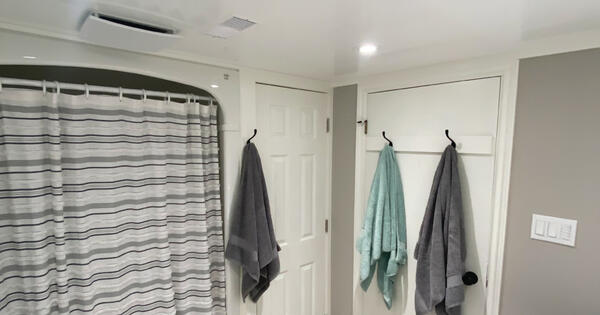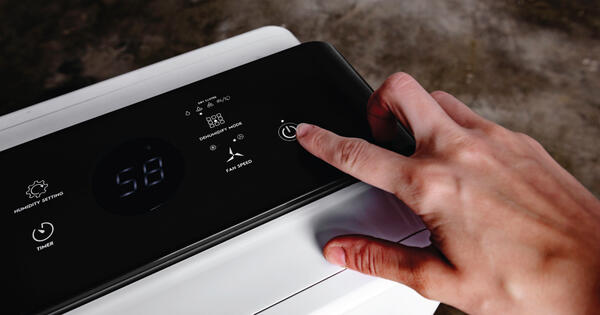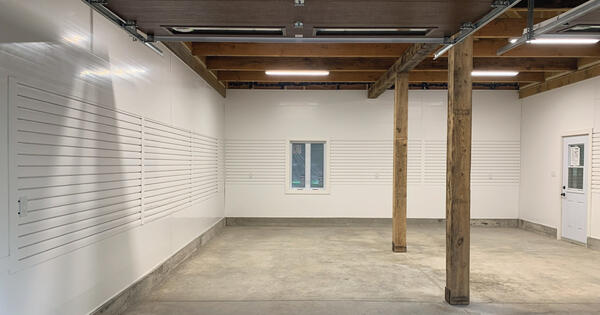Mold in garages isn't just an eyesore — it can lead to bigger problems that affect both your home's structure and your health. Garages are often overlooked when it comes to maintenance, making them a prime spot for mold to thrive unnoticed. Over time, mold can weaken walls, damage stored items, and create unpleasant odors that are hard to ignore. Worse yet, mold spores can contribute to respiratory issues, allergies, and other health problems for you and your family.
To catch mold early, keep an eye out for key warning signs. Look for dark, irregular patches on walls or ceilings, especially in corners or areas near the floor. A musty, damp smell is another red flag. Peeling paint, warped drywall, and water stains can all point to hidden mold growth that needs attention sooner rather than later.
Why Mold Develops in Garage Walls
Garages are more prone to mold than other areas of the house because they often provide the perfect environment for spores to grow. Unlike living spaces, garages typically lack proper insulation, heating, and ventilation. As a result, temperature fluctuations, humidity, and dampness can create ideal conditions for mold to take hold.
Several factors contribute to mold growth in garages:
- High humidity – Moisture from outdoor air or vehicles can build up inside the garage, especially during rainy or snowy seasons.
- Poor ventilation – Without regular airflow, trapped moisture lingers and encourages mold spores to spread.
- Leaks and condensation – Water from roof leaks, plumbing issues, or condensation on cold surfaces can seep into walls and corners, fueling mold growth.
- Organic materials – Mold thrives on surfaces like drywall, wood, and unsealed concrete, all of which can be found in most garages.
The type of wall material also plays a role. Drywall and plywood are especially vulnerable to mold because they absorb moisture quickly. On the other hand, materials like PVC panels or metal tend to resist mold growth better, making them a smart choice for mold-prone spaces.
Signs and Symptoms of Mold in Garage Walls
Spotting mold early can save you from costly repairs and potential health risks. Mold isn’t always obvious, but there are telltale signs to watch for.
Mold often appears as black, green, or white patches on walls, though it can sometimes look fuzzy or slimy. The texture can vary — dry and powdery in some cases, or damp and spongy in others. A persistent musty smell is often one of the first indicators that mold is present, even if you can’t see it.
Hidden mold can be trickier to detect but can show up in subtle ways. Pay attention to:
- Peeling paint or wallpaper – Moisture behind the walls can cause surfaces to bubble or flake.
- Discoloration – Stains that grow or darken over time could indicate mold beneath the surface.
- Unexplained allergy symptoms – If you notice coughing, sneezing, or eye irritation that worsens when you’re in the garage, mold could be to blame.
Mold often hides in less obvious places — behind shelving, in corners, or along the edges of garage doors. Regular inspections and addressing any moisture issues promptly can help keep mold at bay.

How to Safely Identify Mold
If you suspect mold in your garage, the first step is to safely inspect the area. While minor mold patches can often be identified by homeowners, more significant infestations may require professional assessment. Safety is key — mold spores can be hazardous if inhaled or touched.
When inspecting for mold, wear gloves, an N95 mask, and safety goggles to minimize exposure to mold spores. Here are three ways to identify mold in your garage:
- Scan for Visual Cues – Mold can appear in black, green, white, or brown colors and may have a fuzzy, slimy, or powdery texture. Pay close attention to corners, baseboards, areas near windows and doors, and on walls and ceilings, especially where there is water damage or leaks. It is also important to check behind stored items that are rarely moved, as mold can develop unnoticed in these spaces.
- Use a Moisture Meter – Use a moisture meter to check the walls, ceilings, and floors. Mold often grows in areas with moisture readings above 15%, which may indicate that the area is at risk of mold development.
- Use a Test Kit – Home mold testing kits from hardware stores. These kits can detect airborne mold spores that may not be immediately obvious. Send them to a lab for analysis, confirming the presence and type of mold.
Pay close attention to corners, baseboards, areas near windows and doors, and on walls and ceilings, especially where there is water damage or leaks. It is also important to check behind stored items that are rarely moved, as mold can develop unnoticed in these spaces.
For mold hidden behind walls, consider using an infrared camera to detect heat variations that could point to moisture. Alternatively, drilling small inspection holes in inconspicuous areas can allow for visual confirmation without extensive damage.
How to Remove Mold from Garage Walls
Mold removal is essential to prevent further damage and protect your health. For small mold patches, homeowners can often handle the process themselves, but larger infestations require professional remediation to ensure complete removal.
Follow these steps for effective mold removal:
- Step 1: Prepare the Area – Clear the affected space and lay down plastic sheets to protect the surrounding areas. Ensure good ventilation by opening windows or using fans.
- Step 2: Apply Cleaning Solution – Use vinegar, bleach, or commercial mold removers. Vinegar is natural and non-toxic, while bleach is effective on non-porous surfaces.
- White Vinegar – Spray undiluted vinegar directly onto the mold. Let it sit for an hour, then scrub with a brush and wipe clean. Vinegar kills about 82% of mold species.
- Baking Soda Solution – Mix 1 tablespoon of baking soda with water in a spray bottle. Apply to the mold, scrub, and wipe away. Baking soda also helps prevent mold regrowth.
- Hydrogen Peroxide (3%) – Spray hydrogen peroxide onto the mold. Let it sit for 10 minutes, scrub, and rinse.
- Commercial Mold Cleaners – Use a mold-specific cleaner, following the manufacturer’s instructions.
- Bleach Solution (for non-porous surfaces only) – Mix 1 cup of bleach with 1 gallon of water. Apply to the mold, scrub, and rinse thoroughly. Avoid using bleach on porous materials like drywall, as it may not penetrate deep enough to kill mold roots.
- Step 3: Scrub Thoroughly – Use a scrub brush to remove mold from the surface, paying close attention to cracks and crevices. Use a damp cloth to wipe surfaces after scrubbing. Rinse the area and repeat as necessary.
- Step 4: Dry Completely – Mold thrives in damp environments, so use fans, dehumidifiers, or heaters to thoroughly dry the area.
- Step 5: Monitor for Regrowth – Keep an eye on the area over the next few weeks. If mold returns, consider professional assistance.
If the mold infestation is widespread or recurring, don't hesitate to call a professional mold remediation service. Experts have the tools and knowledge to safely remove mold and prevent it from returning.
How to Prevent Mold in Garage Walls
The best way to handle mold is to prevent it from developing in the first place. Since moisture is the primary cause, reducing humidity and improving airflow can make a significant difference.
To keep your garage dry and mold-free:
- Control Moisture Levels – Start by sealing any leaks or cracks in the roof, walls, or around windows and doors. Water can easily seep into these vulnerable areas, creating the perfect conditions for mold to thrive. Ventilation also plays a key role — install vents or use fans to promote airflow, especially if you live in a humid climate. Opening the garage door periodically can help circulate fresh air and reduce excess moisture. Additionally, running a dehumidifier can keep humidity levels below 50%, which makes the environment less favorable for mold growth.
- Manage Water and Condensation – I f you have any leaking pipes or water heaters in the garage, repairing them immediately will help prevent water from pooling. It’s also essential to direct rainwater away from the garage by ensuring gutters and downspouts are clean and functioning properly. Adding weather stripping to doors and windows can block moisture from seeping in, offering an extra layer of protection.
- Keep Surfaces Dry – If water spills or condensation builds up, drying the area with a towel or fan right away will prevent lingering moisture. Be mindful of storing wet or damp items inside the garage — garden tools, rags, or umbrellas should always dry outside before being put away.
- Use Mold-Resistant Materials – Installing mold-resistant wall panels, such as PVC or drywall designed to resist moisture, adds an extra layer of defense. Mold-resistant primer and paint on walls and ceilings also provide long-term protection, making it harder for mold to take hold.
Consistent upkeep and moisture control are essential for preventing mold in garages, protecting both the structure and the contents inside.
How Trusscore Wall&CeilingBoard Helps Prevent Mold Growth
When it comes to mold prevention in garages, Trusscore Wall&CeilingBoard outperforms traditional drywall by a long shot.
One of the biggest advantages is its resistance to moisture — while drywall absorbs water and becomes a breeding ground for mold, Trusscore Wall&CeilingBoard panels are made from PVC, which doesn’t soak up moisture. This makes them naturally mold-resistant, even in damp or humid environments.
Trusscore products are designed to handle the exact conditions that lead to mold growth in garages. They’re non-porous and impervious to water, preventing mold from taking hold on their surface. Additionally, Trusscore panels are easy to clean — if mold ever appears due to external factors, a simple wipe-down with standard cleaning solutions can eliminate it without damaging the material.
If your garage already has drywall or another mold-prone material, retrofitting with Trusscore is a simple way to prevent future mold issues. The panels can be installed directly over existing surfaces, providing an instant moisture barrier. This not only stops mold growth but also brightens up the space with the panels’ clean, bright finish.



Common Mistakes Homeowners Make When Dealing with Mold
Tackling mold in your garage can feel like a quick fix, but certain mistakes can actually make the problem worse. One of the most common missteps is painting or sealing over mold without properly cleaning and treating the area first. Mold doesn’t just disappear under a coat of paint — it continues to grow underneath, often spreading further and weakening the surface over time.
Another mistake is relying too heavily on bleach alone. While bleach kills mold on hard, non-porous surfaces, it doesn’t penetrate materials like drywall, meaning the mold inside can continue to thrive. In some cases, scrubbing mold aggressively can even release more spores into the air, making the situation worse.
Homeowners also fall for myths — like the belief that mold only grows in warm environments. In reality, mold can develop in cold garages if there’s enough moisture present. Similarly, some assume small patches of mold are harmless, but even limited growth can indicate deeper issues that need attention.
Preventing and removing mold from your garage is all about staying proactive. By managing moisture levels, improving ventilation, and choosing materials like Trusscore Wall&CeilingBoard, you can significantly reduce the risk of mold growth. Addressing mold early not only protects your garage but also prevents costly repairs and potential health issues down the road.
For homeowners dealing with persistent mold problems, upgrading garage walls to mold-resistant materials is a worthwhile investment. Trusscore offers a long-term solution that keeps your garage clean, bright, and mold-free. For more information on mold prevention or to explore Trusscore products, reach out to a local dealer.






